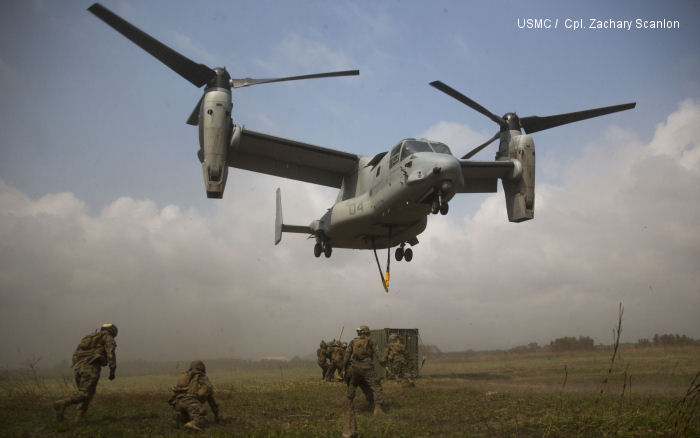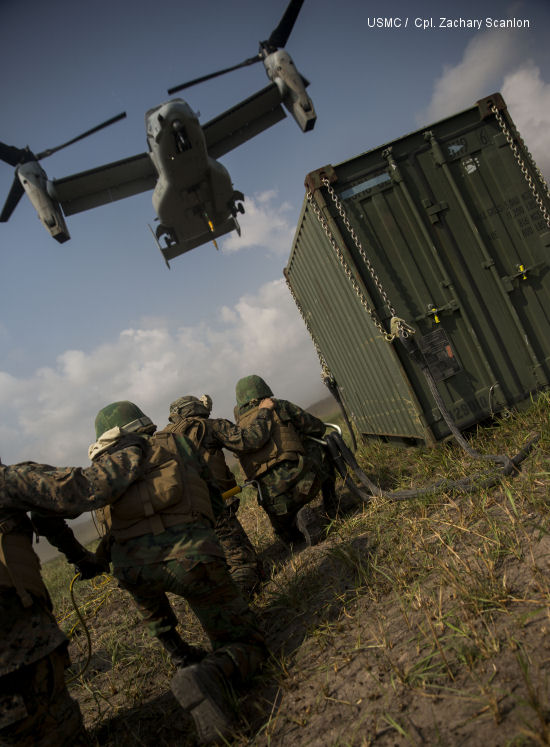US Marine Corps, February 18, 2014 - UTAPHAO, Thailand by MC1 Joy M. Kirch-Kelling - Royal Thai and U.S. Marines conducted a bilateral external lift exercise with an MV-22B Osprey at Utaphao, Kingdom of Thailand Feb. 17 during exercise Cobra Gold 2014.
Roaring in with the ferocity of a mini-tornado, the Osprey kicked up enough dust and debris to completely engulf the aircraft and ground crew below. Jointly the propellers are capable of roughly 12,000 horse power, which potentially can produce ground speed winds up to 200 mph.
These are the conditions the Thai and U.S. Marines had to work in to complete their training mission.
Ospreys are multi-mission capable vehicles with the vertical takeoff functionality of a helicopter but with the performance abilities of a turboprop aircraft. Able to transport supplies or troops from ship to shore or shore to shore, this versatile aircraft is ideal for both combat and humanitarian missions.
Being the first time working with an Osprey, the platoon of Royal Thai Marines, with Landing Force Company, was faced with a whole new challenge they have never seen.
“I have only read about this kind of operation in books,” said Royal Thai Marine Chief Petty Officer 1st Class Wichan Makasiri, a shore manager with Landing Force Company, Support Regiment, Marine Division. “Since this was my first time under an Osprey, I had mix feeling of excitement and nervousness.”
With this being bilateral training though, the U.S. Marines did what any Marine of any country would do, “Never leave a Marine behind.” Each Thai Marine paired with a U.S. Marine to fight against hurricane-esque winds to practice attaching a container to the hovering Osprey.
“The (U.S.) Marines were right there with us under the aircraft,” said Makasiri. “Through the rough winds and scorching heat, we worked together to accomplish the mission.”
Prior to the exercise as well the Royal Thai Marines and U.S. Marines went over protocol and procedures to ensure the interoperability during the bilateral training.
“Working with the Thai’s helps for future operation,” said U.S. Marine Staff Sgt. Casey Wojtkowski, a landing support specialist with Combat Logistics Battalion 4, Combat Logistics Regiment 3, 3rd Marine Logistics Group. “If we ever have to work with a local military force, like Thailand, we will be prepared with a uniformed way of operating and do not have to worry about their military needing to learn on the spot. We can just focus on accomplishing the mission safe and with swiftness.”
Recently that need for cohesion was put to the test as CLB 4 worked with Philippine service members to deliver relief aid in the wake of Typhoon Haiyan/Yolanda which devastated the Philippine Islands November 8th of last year.
Cobra Gold may be a recurring exercise between the Thai, U.S. and participating military forces being in its 33rd iteration, but for the new service members involved of each country it is there first time to build relations and strength the ties that hold them together.
Roaring in with the ferocity of a mini-tornado, the Osprey kicked up enough dust and debris to completely engulf the aircraft and ground crew below. Jointly the propellers are capable of roughly 12,000 horse power, which potentially can produce ground speed winds up to 200 mph.
These are the conditions the Thai and U.S. Marines had to work in to complete their training mission.
Ospreys are multi-mission capable vehicles with the vertical takeoff functionality of a helicopter but with the performance abilities of a turboprop aircraft. Able to transport supplies or troops from ship to shore or shore to shore, this versatile aircraft is ideal for both combat and humanitarian missions.
Being the first time working with an Osprey, the platoon of Royal Thai Marines, with Landing Force Company, was faced with a whole new challenge they have never seen.
“I have only read about this kind of operation in books,” said Royal Thai Marine Chief Petty Officer 1st Class Wichan Makasiri, a shore manager with Landing Force Company, Support Regiment, Marine Division. “Since this was my first time under an Osprey, I had mix feeling of excitement and nervousness.”
With this being bilateral training though, the U.S. Marines did what any Marine of any country would do, “Never leave a Marine behind.” Each Thai Marine paired with a U.S. Marine to fight against hurricane-esque winds to practice attaching a container to the hovering Osprey.
“The (U.S.) Marines were right there with us under the aircraft,” said Makasiri. “Through the rough winds and scorching heat, we worked together to accomplish the mission.”
Prior to the exercise as well the Royal Thai Marines and U.S. Marines went over protocol and procedures to ensure the interoperability during the bilateral training.
“Working with the Thai’s helps for future operation,” said U.S. Marine Staff Sgt. Casey Wojtkowski, a landing support specialist with Combat Logistics Battalion 4, Combat Logistics Regiment 3, 3rd Marine Logistics Group. “If we ever have to work with a local military force, like Thailand, we will be prepared with a uniformed way of operating and do not have to worry about their military needing to learn on the spot. We can just focus on accomplishing the mission safe and with swiftness.”
Recently that need for cohesion was put to the test as CLB 4 worked with Philippine service members to deliver relief aid in the wake of Typhoon Haiyan/Yolanda which devastated the Philippine Islands November 8th of last year.
Cobra Gold may be a recurring exercise between the Thai, U.S. and participating military forces being in its 33rd iteration, but for the new service members involved of each country it is there first time to build relations and strength the ties that hold them together.
See also |
MV-22 in






